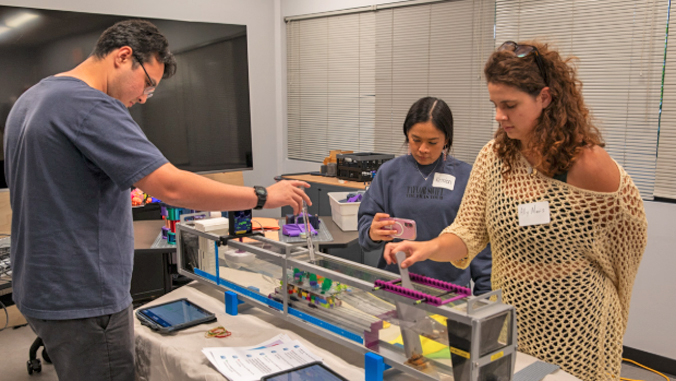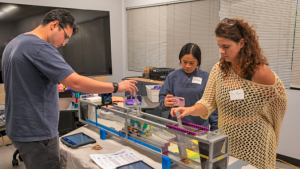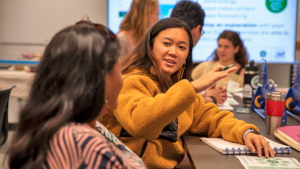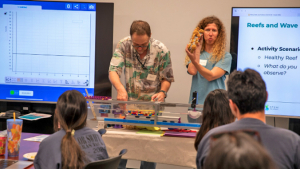

Hawaiʻi middle school teachers came together at the Mānoa Innovation Center on April 26, for a workshop that explored questions such as: ‘Why do scientists predict worse coastal flooding if reefs are degraded?’, ‘How are scientists able to predict surf conditions?’, and ‘Why are engineers designing and testing different types of wave energy buoys?’

The Waves, Reefs, and Resilience Workshop was hosted by the University of Hawaiʻi STEM Pre-Academy and co-developed by a group of 10 researchers, students and staff from multiple departments across campus at UH Mānoa. With support from the National Science Foundation, co-principal investigators Ning Li and Lucia Hosekova brought their vision of helping teachers bring real-world ocean science into their classrooms to life.
“This engaging and informative workshop, focused on local wave, reef, and coastal resilience conditions, aims to bridge the knowledge gap between academic and educational communities,” Li said.

Through a series of demonstrations and expert talks, teachers learned how ocean waves are generated and how energy is transferred by waves. Teachers used wave tanks to explore how waves move, tested different ways to measure wave height and energy, and used model reefs to see how coral can help dissipate wave energy before it reaches the shore. They also learned how rising sea levels and other threats to our reefs might impact Hawaiʻi’s coastlines.
“Coming together with scientists, engineers and teachers at this workshop reminded me how powerful it is when we all work toward a shared purpose,” said Tina T. Young, a teacher at Waipahu Intermediate and graduate of Kapiʻolani Community College and UH Mānoa. “I’m excited to bring what we created back to my students—including a hands-on wave simulator that shows how waves contribute to coastal erosion, and a fun LEGO model to demonstrate why reefs are so important. I know these activities will spark their curiosity and deepen their love and care for the ʻāina we all call home.”

The workshop included classroom-ready activities, take-home supplies, and access to teaching tools such as demo kits and wave tanks. It was designed to match middle school science standards and help teachers make science fun and meaningful for their students.
“It was a joy to see the passion with which the facilitators and teachers approached these topics and brought their own unique experiences and knowledge,” Hosekova said.
Since registration for the workshop filled up quickly, organizers are looking at ways to offer more workshops in the future to meet the strong interest.
“These workshops are a vital step in building lasting, community-centered conversations around ocean renewable energy, and I look forward to expanding future sessions with even more opportunities for collaboration, listening and shared discovery,” said Troy Heitmann, a workshop facilitator and Hawaiʻi Natural Energy Institute assistant researcher.
Educators who are interested in wave-related resources can explore the PacIOOS Education Resources, Exploring our Fluid Earth (secondary), Sea Earth Atmosphere (elementary) and the STEM Pre-Academy teacher resources. To be notified of future opportunities, sign up for the STEM Pre-Academy mailing list.
UH STEM Pre-Academy is housed in the UH Office of the Vice President for Research and Innovation.

